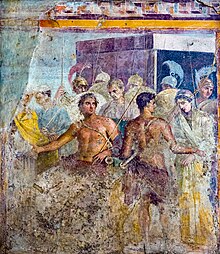
Back بريسيز Arabic Брысеіда Byelorussian Бризеида Bulgarian Briseis Breton Briseida Catalan Bríseovna Czech Briseis German Βρισηίδα Greek Briśèide EML Brizeis Esperanto


Briseis (/braɪˈsiːɪs/; Ancient Greek: Βρισηίς Brīsēís, pronounced [briːsɛːís]) ("daughter of Briseus"), also known as Hippodameia (Ἱπποδάμεια, [hippodámeːa]),[2] is a significant character in the Iliad. Her role as a status symbol is at the heart of the dispute between Achilles and Agamemnon that initiates the plot of Homer's epic. She was married to Mynes, a son of the King of Lyrnessus, until the Achaeans sacked her city and was given to Achilles shortly before the events of the poem. Being forced to give Briseis to Agamemnon, Achilles refused to reenter the battle.[3]
- ^ Beazley Archive 203900.
- ^ From the A scholium at Iliad 1.392 we learn that "[Homer] forms the names [of Briseïs and Chryseis] patronymically. For as other ancient [poets] relate, Chryseis was called Astynome, and Briseis was called Hippodameia." Dictys Cretensis calls Briseis by the latter name in his account of the Trojan War. See Dué 2002: Homeric Variations on a Lament by Briseis 56-58.
- ^ Roman, Luke; Roman, Monica (2010). Encyclopedia of Greek and Roman Mythology. Infobase Publishing. p. 105. ISBN 978-1-4381-2639-5.
© MMXXIII Rich X Search. We shall prevail. All rights reserved. Rich X Search